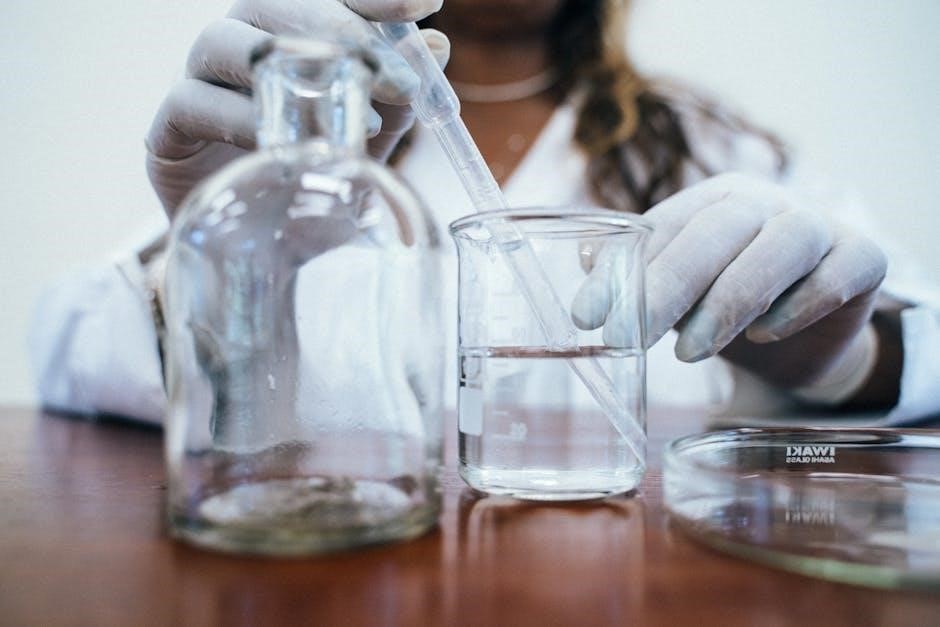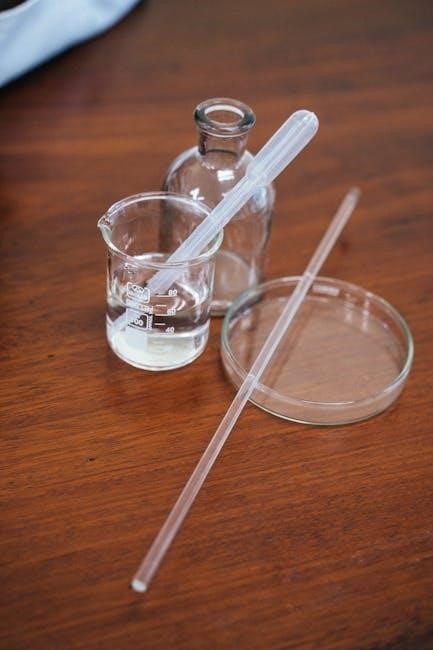This lab explores water’s unique properties, such as polarity, surface tension, and cohesion, through hands-on experiments and data analysis, essential for understanding its biological and environmental roles․
Importance of Water in Biological Systems
Water is indispensable in biological systems, serving as a universal solvent and medium for cellular reactions․ Its unique chemical properties, such as high specific heat and hydrogen bonding, regulate temperature and facilitate metabolic processes․ Water’s polarity enables it to dissolve salts, nutrients, and waste products, making it vital for nutrient transport and detoxification․ In organisms, water maintains cellular structure, lubricates joints, and aids in digestion and circulation․ Its cohesive properties support capillary action, essential for nutrient uptake in plants and blood circulation in animals․ Without water, life as we know it would cease, as it is fundamental to enzyme function, protein folding, and DNA stability․ Understanding water’s biological roles highlights its irreplaceable significance in sustaining life and ecosystems․ This lab emphasizes these properties to illustrate why water is often called the “molecule of life․”
Overview of the Lab Objectives
This lab is designed to investigate the unique chemical and physical properties of water, such as polarity, surface tension, cohesion, and high specific heat capacity․ Students will conduct experiments to measure surface tension, observe capillary action, and test pH levels in various water samples․ The objectives include understanding how hydrogen bonding contributes to water’s unique characteristics and analyzing data to draw conclusions about its behavior․ Additionally, the lab emphasizes safe handling of chemicals and equipment, adherence to safety protocols, and proper documentation of results․ By exploring these properties, participants will gain insights into why water is essential for life and its critical role in biological and environmental systems․ This hands-on approach encourages scientific inquiry and data-driven reasoning, preparing students to interpret and communicate their findings effectively․

Chemical and Physical Properties of Water

This section examines water’s unique chemical and physical properties, such as its molecular structure, polarity, hydrogen bonding, and high specific heat capacity, essential for its role in biological and environmental systems․
Molecular Structure of Water (H2O)
Water’s molecular structure consists of one oxygen atom covalently bonded to two hydrogen atoms, forming a bent or V-shaped molecule․ This structure, with oxygen’s lone pairs, creates a polar molecule․ The oxygen-hydrogen bonds are polar due to the difference in electronegativity, making water a unique solvent․ This polarity allows water to dissolve a wide variety of substances, enhancing its role in biological systems․ The molecular structure also contributes to properties like high surface tension and cohesion․ In lab experiments, understanding this structure helps explain phenomena such as capillary action and hydrogen bonding․ This foundational knowledge is crucial for analyzing water’s behavior in various scientific and real-world applications․

Polarity and Hydrogen Bonding
Water’s polarity arises from its molecular structure, where oxygen’s higher electronegativity creates a partial negative charge, while hydrogen atoms carry a partial positive charge․ This polarity allows water to form hydrogen bonds, weak electrostatic attractions between molecules․ These bonds are crucial for water’s unique properties, such as high surface tension and cohesion․ Hydrogen bonding also explains water’s ability to dissolve ionic and polar substances, making it an excellent solvent․ In biological systems, these interactions facilitate chemical reactions and maintain cellular structures․ Lab experiments often demonstrate hydrogen bonding through phenomena like capillary action and surface tension measurements․ Understanding polarity and hydrogen bonding is essential for explaining water’s role in both living organisms and environmental processes․ These properties highlight why water is vital for life and central to many scientific investigations․
High Specific Heat Capacity
Water’s high specific heat capacity, approximately 4․186 joules per gram per degree Celsius, allows it to absorb and release large amounts of heat without significant temperature changes․ This property is crucial for moderating Earth’s climate, as oceans and lakes absorb heat during the day and release it slowly, preventing extreme temperature fluctuations․ In biological systems, this capacity helps maintain stable internal temperatures in organisms, ensuring proper cellular functions․ During lab experiments, measuring the specific heat of water demonstrates its ability to resist rapid temperature changes, showcasing its role in regulating both environmental and biological systems․ This unique property underscores water’s essentiality in sustaining life and balancing ecosystems․ Understanding this characteristic is vital for grasping water’s influence on climate and its role in various scientific and real-world applications․

Safety Protocols in the Water Lab
Adhering to safety protocols is crucial, involving proper handling of chemicals, emergency preparedness, and referencing Safety Data Sheets to ensure safe procedures and prevent accidents․
Handling Chemicals and Equipment
Proper handling of chemicals and equipment is essential to ensure safety and accuracy in the water lab․ Always read and follow the Safety Data Sheets (SDS) for chemicals like potassium hydroxide, which may be used in certain experiments․ Wear appropriate personal protective equipment (PPE), such as gloves, goggles, and lab coats, when handling chemicals․ Ensure all equipment, including thermometers, pH meters, and graduated cylinders, is calibrated and in good working condition before use․ Familiarize yourself with emergency procedures, such as spill cleanup and eye wash stations, to handle accidental exposures․ Never mix chemicals without prior authorization, and store them in their designated areas․ Label all samples clearly and avoid tasting or smelling substances․ Properly clean and dispose of materials after experiments to maintain a safe and organized lab environment․
Emergency Procedures and Safety Data Sheets

Understanding emergency procedures and Safety Data Sheets (SDS) is crucial for maintaining a safe environment in the water lab․ Always review the SDS for any chemical used, as it provides critical information on handling, storage, and emergency response․ In case of chemical exposure, immediately flush the affected area with water for at least 15 minutes and seek medical attention․ Spills should be contained using absorbent materials, and spill kits should be readily available․ Know the location of emergency exits, fire extinguishers, and eyewash stations․ Regular drills and training ensure preparedness for unexpected situations․ Familiarize yourself with the lab’s emergency contact list and protocols for fires, spills, or equipment malfunctions․ Properly documenting incidents and following cleanup procedures helps prevent future accidents and ensures compliance with safety regulations․

Key Experiments in the Water Lab
- Measure surface tension to demonstrate water’s cohesive properties․
- Observe capillary action and adhesion in different materials․
- Test pH levels in various water samples for acidity/basicity․
Measuring Surface Tension
Surface tension is a critical property of water, influenced by its molecular structure and hydrogen bonding․ In this experiment, students measure surface tension using simple tools like a penny or a dropper․ By observing how many water drops can be placed on a penny before spilling, the cohesive forces are demonstrated․ This activity highlights water’s ability to resist external forces due to its high surface tension․ The results are compared with other liquids, such as alcohol, to illustrate variations in surface tension․ This experiment helps students understand the role of hydrogen bonds in maintaining water’s unique properties․ The lab also connects to real-world phenomena, such as water striders walking on water, emphasizing the practical significance of surface tension․
Demonstrating Cohesion and Adhesion
This experiment highlights water’s unique cohesive and adhesive properties․ Cohesion refers to the attraction between water molecules due to hydrogen bonding, while adhesion is the attraction between water and another substance․ To demonstrate these properties, students often use a paper clip floating on water, which relies on cohesion, or place a drop of water on a surface to observe its spreading behavior․ These activities show how water molecules stick together and interact with other materials․ The lab also explores capillary action, where water rises in a narrow tube due to the balance of cohesive and adhesive forces․ Understanding these properties helps explain phenomena like plant water transport and water’s role in biological systems․ The experiments provide a hands-on way to visualize and measure the effects of cohesion and adhesion in water․
Observing Capillary Action
Capillary action is a phenomenon where water rises through a narrow tube or porous material without external force․ This experiment demonstrates how water molecules interact with a surface, relying on the balance between cohesive and adhesive forces․ Students place a thin tube or paper strip into a beaker of water, observing how water climbs the tube due to hydrogen bonding․ The height reached depends on the tube’s diameter and the material’s properties․ This action illustrates how plants transport water from roots to leaves, highlighting water’s essential role in biological systems; The lab provides a visual representation of capillary action, enabling students to understand its practical applications in nature and everyday life․ By measuring and recording the water’s rise, students gain hands-on insight into this fundamental property of water․
Testing pH Levels in Different Water Samples
This experiment involves measuring the pH levels of various water samples to understand their acidity or basicity․ Students use pH indicators or meters to test samples such as tap water, distilled water, and natural water sources․ The pH scale ranges from 0 to 14, with 7 being neutral․ Pure water is slightly acidic due to the dissociation of hydrogen ions, but environmental factors can alter this․ For example, rainwater may be acidic due to dissolved CO2, while mineral-rich water could be basic․ This activity helps students recognize how pH affects water quality and its suitability for different uses․ By comparing results, they learn to identify potential contaminants and understand the importance of pH in biological systems and ecosystems․ This hands-on approach reinforces the concept of water as a solvent and its role in chemical interactions․
Analyzing Lab Results
Accurate data interpretation is crucial for understanding water’s properties․ Lab results reveal insights into surface tension, cohesion, and pH levels, aiding in drawing meaningful conclusions about water’s behavior and applications․
Interpreting Data on Surface Tension and Viscosity
Surface tension and viscosity are critical properties of water that influence its behavior in various systems․ Surface tension, measured in units of force per length, indicates water’s resistance to disruption at its surface, while viscosity reflects its resistance to flow․ Lab experiments often involve comparing these properties across different liquids or under varying conditions, such as temperature changes․ Higher surface tension in water is attributed to its polar nature and hydrogen bonding, which create strong intermolecular forces․ Viscosity, on the other hand, decreases as temperature increases, affecting how water flows and interacts with its environment․ Accurate interpretation of these datasets is essential for understanding water’s unique characteristics and their practical applications in fields like biology and engineering․ By analyzing these properties, students gain insights into why water behaves differently from other substances and how its properties impact real-world phenomena․
Understanding the Role of Hydrogen Bonds
Hydrogen bonds play a pivotal role in determining water’s unique properties and behavior․ These weak electrostatic attractions occur between the oxygen atom of one water molecule and the hydrogen atoms of another, forming a dynamic network․ Hydrogen bonding is responsible for water’s unusually high boiling point and surface tension, as well as its ability to exhibit cohesion and adhesion․ In lab experiments, observing phenomena like capillary action and surface tension demonstrates the strength of these intermolecular forces․ Hydrogen bonds also contribute to water’s high specific heat capacity, allowing it to absorb and release heat without drastic temperature changes․ This property is crucial for regulating Earth’s climate and supporting life․ By studying hydrogen bonds, students can better understand how water’s molecular structure translates into its essential roles in biological systems and environmental processes․ Analyzing lab data helps reinforce these concepts and their practical implications․

Common Questions and Answers
This section addresses frequently asked questions about water’s properties, such as its role in biological systems, surface tension, and hydrogen bonding, providing clear, concise answers based on lab findings․
Why is Water Essential for Life?

Water is indispensable for life due to its unique chemical and physical properties․ It serves as a universal solvent, facilitating the transport of nutrients and waste within organisms․ Its high specific heat capacity helps regulate temperature, maintaining stable conditions for biochemical processes․ Hydrogen bonding in water contributes to surface tension and cohesion, essential for biological functions like capillary action in plants․ Additionally, water is a medium for chemical reactions and processes such as photosynthesis and digestion, crucial for energy production․ Its polarity enables interactions with other substances, supporting life’s fundamental operations․ Without water, life as we know it would not exist, as it is vital for cell structure, metabolic activities, and overall biological stability․
How Does Water’s High Specific Heat Affect Climate?
Water’s high specific heat capacity significantly influences Earth’s climate by moderating temperature fluctuations․ This property allows water to absorb and release large amounts of heat without rapid temperature changes․ In oceans, lakes, and rivers, water absorbs solar energy, storing it during warmer months and releasing it gradually, preventing extreme temperature swings․ This buffering effect stabilizes climates, moderates weather patterns, and prevents abrupt transitions between seasons․ Coastal areas particularly benefit from this regulation, maintaining milder temperatures compared to inland regions․ Additionally, water’s high specific heat contributes to the formation of weather systems, such as clouds and precipitation, which distribute heat and moisture globally․ This regulation is crucial for maintaining Earth’s climate balance and supporting life, as it prevents environmental extremes and fosters a stable habitat for diverse ecosystems․

Summarize key findings, document observations accurately, and ensure all safety protocols are followed when conducting experiments on water’s properties․ Proper reporting enhances understanding and reproducibility of results․
Summarizing Key Findings
In the water properties lab, key findings revealed water’s unique characteristics, such as high surface tension and cohesion, due to hydrogen bonding․ Experiments demonstrated capillary action, viscosity, and the role of polarity in adhesion․ The specific heat capacity of water was observed to regulate temperature changes, while pH testing highlighted variations in water samples․ These properties underscore water’s essential role in biological systems and environmental processes․ Clear documentation and analysis of data are crucial for accurate conclusions and future research applications․
Best Practices for Documenting Lab Results
Accurate and detailed documentation is critical for valid lab conclusions․ Record all observations, measurements, and calculations clearly and legibly․ Use standardized units and ensure data is organized in tables or graphs when appropriate․ Include raw data, not just calculated values, to maintain transparency․ Label all figures and charts with descriptive titles and axes․ Document unexpected results and any deviations from procedures․ Use bullet points for clarity and ensure headings are clear․ Always reference safety protocols followed during experiments․ Store electronic copies securely and submit reports on time․ Peer review of documentation can help identify errors․ Adhere to lab manual guidelines for formatting and content․ Proper documentation ensures reproducibility and credibility of findings, making it essential for scientific integrity․

